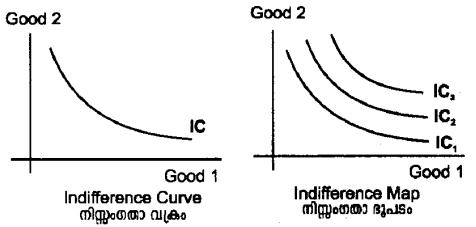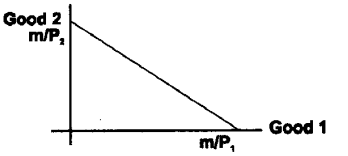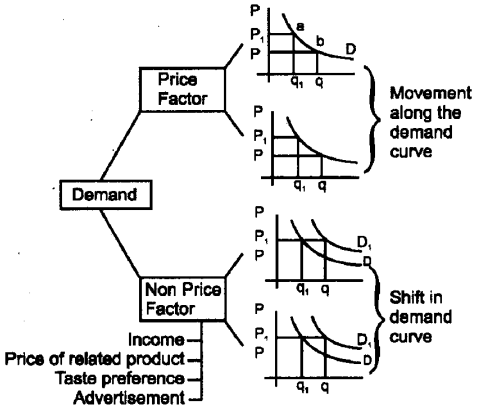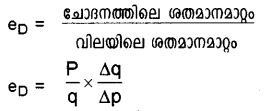Kerala Plus Two Microeconomics Notes Chapter 2 Theory of Consumer Behaviour
Introduction
Those who purchase and use goods for their satisfaction are known as consumers. The want satisfying power of a commodity is known as utility.
ആമുഖം: തന്റെ ആവശ്യങ്ങളെ തൃപ്തിപ്പെടുത്തുന്നതിനുവേണ്ടി സാധനങ്ങളും സേവന ങ്ങളും വാങ്ങുകയും ഉപയോഗിക്കു കയും ചെയ്യുന്ന വ്യക്തികളെ ഉപഭോക്താക്കൾ എന്ന് പറയുന്നു. ഉപഭോക്താവിന്റെ ആവശ്യങ്ങളെ തൃപ്തിപ്പെടുത്താനുള്ള സാധ നങ്ങളുടെ കഴിവിനെയാണ് ഉപയുക്തത എന്ന് പറയുന്നത്.
A) Consumption Bundle: Normally, a consumer purchases numerous goods and services. However, for simplicity, let us assume that the consumer purchases only two goods namely good 1 and good 2. Consumption bundle can be defined as the combination of quantities of two goods that a consumer can purchase with his limited income.
ഉപഭോഗ ബണ്ടിൽ: ഒരു ഉപഭോക്താവ് സാധാരണയായി പല സാധനങ്ങളും വാങ്ങുന്നു. എന്നാൽ വിശകലനത്തിന്റെ എളു പ്പത്തിനുവേണ്ടി ഉപഭോക്താവ് രണ്ട് സാധനങ്ങൾ മാത്രമെ വാങ്ങുന്നുള്ളു എന്നു കരുതുക. അവയെ സാധനം – 1, സാധ നം – 2 എന്നു വിളിക്കാം. രണ്ടു സാധനങ്ങളുടെ അളവുക ളുടെ സംയോഗത്തെ (combination) ഉപഭോഗ ബണ്ടിൽ എന്നു പറയുന്നു.
B) The Consumer’s Budget:
The consumer may not be in a position to purchase all goods and services at the required quantity. The consumption bundle of a consumer depends on the income of the consumer and the prices of the respective goods he wish to purchase from the market. It means that the consumer can purchase only those consumption bundles which are less than or equal to his level of income and the prices of goods he can afford to pay. Thus, a consumer’s budget indicates the available income of the consumer with which he can purchase various goods and services.
ഉപഭോക്താവിന്റെ ബഡ്ജറ്റ്: ഉപഭോക്താവിന് അയാൾ ആഗ ഹിക്കുന്ന അളവിൽ വിപണിയിൽ നിന്ന് സാധനങ്ങൾ വാങ്ങാൻ കഴിയുകയില്ല. കാരണം ഉപഭോക്താവിന്റെ ഉപഭോഗബണ്ടിലു കൾ സാധനങ്ങളുടെ വിലയേയും അയാളുടെ വരുമാന ത്തേയും ആശ്രയിച്ചിരിക്കുന്നു. അതായത്, ഉപഭോക്താവിന്റെ വരുമാനവും സാധന- സേവനങ്ങളുടെ വിലയും അനുസരിച്ച് അയാളുടെ വരുമാനത്തിന്റെ തുല്യമോ താഴെയൊ വരുന്ന ഉപ ഭോഗ ബണ്ടിലുകൾ മാത്രമെ അയാൾക്കു വാങ്ങാൻ കഴിയൂ.
C) Budget Set: It includes all bundles that are on or below the budget line.
ബജറ്റ് സെറ്റ്: ബജറ്റ് ലൈനിലോ അതിന് താഴെയോ ഉള്ള ബണ്ടിലുകൾ ബജറ്റ് സെറ്റിൽ ഉൾപ്പെടുന്നു.
D) Budget Line: Where P1 is the price of good 1 and P2 is the price of good 2.
ബജറ്റ് ലൈൻ: P1 എന്നത് ഒന്നാമത്തെ വസ്തുവിന്റെ വില യും P2 എന്നത് രണ്ടാമത്തെ വസ്തുവിന്റെ വിലയുമാണ്.
Preferences of the Consumer
The consumer opt the most appropriate consumption bundle from the budget set. Which bundle he would choose depends upon his tastes and preferences. A consumer ranks two consumption bundles as per his preference and then may choose one bundle or may be indifferent between the bundles.
ഉപഭോക്താവിന്റെ മുൻഗണനകൾ : ഒരു ഉപഭോക്താവ് അയാൾക്ക് ആവശ്യമുള്ള ഉപഭോഗ ബണ്ടിലുകൾ തെരഞ്ഞെടുക്കുന്നത് ലഭ്യ മായിട്ടുള്ള ബജറ്റ് സെറ്റിൽ നിന്നാണ്. അയാൾ ഏതു ബണ്ടിൽ തെരഞ്ഞെടുക്കുന്നു എന്നത് അയാളുടെ അഭിരുചിയും മുൻഗ ണനാക്രമവും അനുസരിച്ചായിരിക്കും. ഉപഭോക്താവ് ആദ്യം രണ്ടു ബണ്ടിലുകൽ തമ്മിൽ താരതമ്യം ചെയ്യുന്നു. അതിനുശേഷം ഏതെങ്കിലും ഒരു ബണ്ടിൽ തെരഞ്ഞെടുക്കുകയോ 2 ബണ്ടിലി നോടും നിസംഗത പുലർത്തുകയോ ചെയ്യാം.
Monotonic Preferences
If a consumer prefers to have a bundle which has more goods compared to other bundles then it is known as monotonic preference.
ഏകതാനമായ മുൻഗണനകൾ: കുറഞ്ഞ അളവുള്ള ബണ്ടിലി നേക്കാൾ കൂടുതൽ അളവുള്ള ബണ്ടിലിനോടുള്ള ഉപഭോക്താ വിന്റെ താല്പര്യത്തെ ഏകതാനമായ മുൻഗണന എന്നു വിളി ക്കുന്നു.
Indifference Curve and Indifference Map

The concept of indifference curve was initially developed by Edge Worth. Later on, it was modified by JR Hicsk and RGD Allen in 1939.
Indifference curve is a graphical representation of locus of points of two consumer goods which gives him the same amount of satisfaction. If two consumption bundles give the equal amount of satisfaction to the consumer, we can say that he is indifferent among the consumption bundles. The group of indifference curves available to the consumer is known as indifference map.
നിസ്സംഗതാ വകം: രണ്ടു ഉപഭോഗ ബണ്ടിലുകളും ഉപഭോക്താ വിന് തുല്യ സംതൃപ്തിയാണ് നൽകുന്നതെന്ന് കരുതുക. അതാ യത് ഈ രണ്ടു ബണ്ടിലുകൾക്കിടയിൽ ഉപഭോക്താവ് നിസ്സംഗൻ (indifferent) ആയിരിക്കും .
ഉപഭോക്താക്കൾ നിസ്സംഗരായിരിക്കുന്നതും എന്നാൽ തുല്യ സംതൃപ്തി നൽകുന്നതുമായ ഉപഭോഗ ബണ്ടിലുകളെ ഒരുമിച്ച് യോജിപ്പിച്ചുകൊണ്ട് വരയ്ക്കുന്ന വകത്തെയാണ് നിസ്സംഗതാ വകം എന്ന് പറയുന്നത്. ഉപഭോക്താവിന്റെ താല്പര്യം കാണി ക്കുന്ന നിസ്സംഗതാ വക്രങ്ങളുടെ കൂട്ടത്തെ നിസ്സംഗതാ ഭൂപടം എന്ന് പറയുന്നു.
Properties of Indifference Curve
The following are some of the major properties of indifference curve.
- Indifference curve slopes downward from left to right.
- Indifference curves are convex to the origin.
- Indifference curves never intersect each other.
- Higher indifference curves show higher levels of satisfaction.
- The slope of the indifference curve is negative.
- Indifference curves are not necessarily parallel to each other.
നിസ്സംഗതാ വക്രത്തിന്റെ സവിശേഷതകൾ
- നിസ്സംഗതാ വകം ഇടത്തുനിന്ന് വലത്തോട്ട് താഴേയ്ക്കു ചരി ഞഞ്ഞിരിക്കും.
- നിസ്സംഗതാ വകം ഉന്മധ്യമാണ്. അതിന് കോൺവെക്സ് ആക തിയാണുള്ളത്.
- നിസ്സംഗതാ വക്രങ്ങൾ ഒരിക്കലും പരസ്പരം ചോദിക്കില്ല.
- ഉയർന്ന നിസ്സംഗതാ വകങ്ങൾ ഉയർന്ന സംതൃപ്തിയെ സൂചി പ്പിക്കുന്നു.
- നിസ്സംഗതാ വകത്തിന്റെ ചെരിവ് നെഗറ്റീവ് ആണ്.
- നിസ്സംഗതാ വക്രങ്ങൾ സമാന്തരം ആയിക്കൊള്ളണമെന്നില്ല.
Budget Line

The equation of a budget line P1X1 + P2X2 = m
(P1 = Price of good 1, x1 = Quantity of good 1, P2 = Price of good 2, X2 = Quantity of good 2)
Horizontal intercept m/P1
Vertical intercept m/P2
Slope of the budget line \(-\frac{P_{1}}{P_{2}}\)

ഒരു ബജറ്റ് ലൈനിന്റെ സമവാക്യം
P1X1 + P2X2 = m
P1 = ഒന്നാമത്തെ വസ്തുവിന്റെ വില
P2 = രണ്ടാമത്ത വസ്തുവിന്റെ വില
X1 = ഒന്നാമത്തെ വസ്തുവിന്റെ അളവ്
X2 = രണ്ടാമത്ത വസ്തുവിന്റെ അളവ്
m = ഉപഭോക്താവിന്റെ വരുമാനം
Consumer’s Equilibrium
At the point E the budget line is tangent with indifference curve. It shows the consumer equilibrium.

ഉപഭോക്താവിന്റെ സന്തുലിതാവസ്ഥ: Point E എന്നത് ബജറ്റ് ലൈനും നിസ്സംഗതാ വകവും തമ്മിൽ tangent ആവുന്ന Point നെ കാണിക്കുന്നു. ഇത് ഉപഭോക്താവിന്റെ സന്തുലിതാ വസ്ഥ എന്ന് അറിയപ്പെടുന്നു.
Demand and its Determinants
Demand is the desire for a commodity supported by ability to pay and willingness to pay.
Demand for a commodity is determined by various factors such as
- Price of the commodity
- Price of related commodities
- Income of the consumer
- Taste and preference of the consumer
ചോദനവും അതിനെ നിർണ്ണയിക്കുന്ന ഘടകങ്ങളും: ഒരു ഉപ് ഭോക്താവിന് ഒരു സാധനം വാങ്ങാനുള്ള ആഗ്രഹത്തെയാണ് സാധാരണയായി ചോദനം അഥവാ ഡിമാന്റ് എന്ന്പ റയാറുള്ളത്. എന്നാൽ സാമ്പത്തികശാസ്ത്രത്തിൽ ആഗ്രഹം മാത്രമായാൽ ഡിമാന്റ് ആവുകയില്ല. ആഗ്രഹത്തോടൊപ്പംതന്നെ വില കൊടു ക്കാനുള്ള കഴിവും സന്നദ്ധതയും ഉണ്ടാകണം. ചുരുക്കത്തിൽ, ഒരു സാധനം വില കൊടുത്ത് വാങ്ങാനുള്ള കഴിവും സന്നദ്ധ തയും കൂടിച്ചേർന്നുള്ള ആഗ്രഹത്തെ ചോദനം എന്നു പറയുന്നു.
ചോദനത്തെ നിർണ്ണയിക്കുന്ന ഘടകങ്ങൾ
- സാധനത്തിന്റെ വില
- ബന്ധപ്പെട്ട സാധനങ്ങളുടെ വില
- ഉപഭോക്താവിന്റെ വരുമാനം
- ഉപഭോക്താവിന്റെ അഭിരുചിയും താല്പര്യങ്ങളും
Law of Demand
When other things remaining constant, an increase in price leads to fall in demand and decrease in price leads to rise in demand. This is known as law of demand.
ചോദന നിയമം: ഒരു സാധനത്തിന്റെ വിലയും ചോദനത്തിന്റെ അളവും തമ്മിലുള്ള വിപരീത ബന്ധത്തെ സൂചിപ്പിക്കുന്ന ഒന്നാണ് ചോദന നിയമം. മറ്റു ഘടകങ്ങളിൽ മാറ്റമില്ലെങ്കിൽ (സ്ഥിരമായി നിൽക്കുകയാണെങ്കിൽ) ഒരു സാധനത്തിന്റെ വില കൂടിയാൽ ചോദനം കുറയുകയും വില കുറഞ്ഞാൽ ചോദനം കൂടുകയും ചെയ്യുന്നതിനെയാണ് ചോദനനിയമം എന്ന് പറയുന്നത്.
Changes in demand
i) Expansion and contraction of demand: An increase in demand due to fall in price is known as expansion of demand. A decrease in demand due to rise in price is known as contraction of demand.
ii) Increase and decrease in demand : A rise in demand due to change in other factors is known as increase in demand. A fall in demand due to change in other factors is known as decrease in demand.

ചോദനത്തിലെ മാറ്റങ്ങൾ
i) ചോദനത്തിന്റെ സങ്കോചവും വികാസവും: ഒരു സാധന ത്തിന്റെ വില കൂടിയാൽ അതിന്റെ ചോദനം കുറയുന്നു. ഇതിന്റെ ഫലമായി ചോദനവകം മുകളിലേക്ക് നീങ്ങുന്നു. ഇങ്ങനെ, വില വർധിക്കുന്നതുമൂലം ചോദനത്തിന്റെ അള വിലുണ്ടാകുന്ന കുറവിനെ ചോദനത്തിന്റെ സങ്കോചം എന്നു പറയുന്നു. ചോദനവകത്തിലൂടെ താഴേക്കുള്ള മാറ്റം ഒരു സാധനത്തിന്റെ വില കുറഞ്ഞാൽ അതിന്റെ ചോദനം കൂടു ന്നു. അപ്പോൾ ചോദനവകം താഴേക്കു നീങ്ങുന്നു. ഇങ്ങനെ വില കുറയുന്നതുമൂലം ചോദനത്തിന്റെ അളവിലുണ്ടാകുന്ന വർദ്ധനവിനെ ചോദനത്തിന്റെ വികാസം എന്നു പറയുന്നു.
ii) ചോദന വർദ്ധനവും ചോദന ക്ഷയവും: വിലയേതര ഘടക ങ്ങളിലെ അനുകൂലമായ മാറ്റംമൂലം ചോദനം വർധിക്കു കയും ചോദ ന വകം വല തുഭാഗ ത്തേക്ക് മാറുകയും ചെയ്യുന്നു. ഇതിനെയാണ് ചോദനത്തിന്റെ വർദ്ധനവ് എന്നു പറയുന്നത്. ചോദനത്തെ നിർണ്ണയിക്കുന്ന വിലയേതര ഘട കങ്ങളിലെ പ്രതികൂലമായ മാറ്റം മൂലം ചോദനം കുറയു കയും ചോദനവകം ഇടത്തേയ്ക്ക് (താഴേയ്ക്ക്) മാറുകയും ചെയ്യുന്നു. ഇതിനെയാണ് ചോദനക്കുറവ് (ചോദന ക്ഷയം) എന്നുപറയുന്നത്.
Price Elasticity of Demand
The law of demand explains only about the direction of relationship between price and quantity of commodity demanded. It does not explain how much change happens in demand due to a unit change in price. Price elasticity is a measure used to explain the extent of change in quantity demanded as a result of change in price. It measures the degree of responsiveness of change in quantity demanded as a result of change in price. Thus elasticity of demand (ed) is expressed as

Where, eD = elasticity of demand, p = initial price, q = initial quantity, Δq = change in quantity and ΔP = change in price.
ചോദനത്തിന്റെ വില ഇലാസ്തികത: ചോദന നിയമമനുസരിച്ച് വിലയും ചോദനവും തമ്മിലുള്ള ബന്ധം വിപരീതമാണ്. അതാ യത്, വില കൂടുമ്പോൾ ചോദനം കുറയും; വില കുറയുമ്പോൾ ചോദനം കൂടും. വിലയും ചോദനവും തമ്മിലുള്ള ബന്ധത്തിന്റെ ദിശയെക്കുറിച്ച് മാത്രമാണ് ചോദനനിയമം പറയുന്നത്. വിലയിലെ മാറ്റത്തിനനുസരിച്ച് ചോദനത്തിന്റെ അളവിൽ എത്രകണ്ട് മാറ്റം ഉണ്ടാവുമെന്നതിനെക്കുറിച്ച് ചോദനനിയമം പറയുന്നില്ല. വിലയി ലുണ്ടാകുന്ന മാറ്റമനുസരിച്ച് ചോദനത്തിലുണ്ടാകുന്ന മാറ്റത്തിന്റെ
തോതിനെയാണ് വില ഇലാസ്തികത എന്ന് പറയുന്നത്. ഒരു സാധനത്തിന്റെ വിലയിലുണ്ടാകുന്ന മാറ്റത്തിനനുസരിച്ച് അതി ന്റെ ചോദനത്തിലു ണ്ടാ കുന്ന, പതികരണ ത്തിന്റെ (responsiveness) തോതിനെ ചോദനത്തിന്റെ വില ഇലാസ്തിക (ed) എന്നുപറയുന്നു.

p = ആദ്യ വില
q = ആദ്യ അളവ്
Δq = അളവിലുള്ള മാറ്റം
Δp = വിലയിലുള്ള മാറ്റം
Methods of Measuring Elasticity
There are three methods for measuring elasticity.
They are:
- Percentage method
- Point method
- Expenditure method
ഇലാസ്തികത അളക്കുന്ന രീതികൾ: ചോദനത്തിന്റെ ഇലാസ്തി കത അളക്കാൻ പ്രധാനമായും 3 രീതികൾ ഉപയോഗിക്കാറുണ്ട്. അവ താഴെ പറയുന്നവയാണ്.
- ശതമാന രീതി
- പോയിന്റ് രീതി
- ചെലവ് രീതി